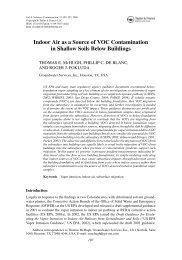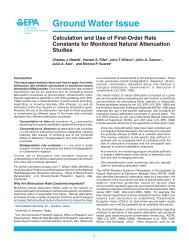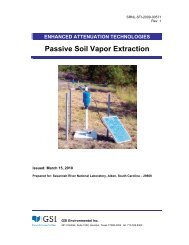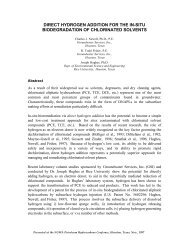Parameter Estimation Guidelines for Risk-Based Corrective Action ...
Parameter Estimation Guidelines for Risk-Based Corrective Action ...
Parameter Estimation Guidelines for Risk-Based Corrective Action ...
Create successful ePaper yourself
Turn your PDF publications into a flip-book with our unique Google optimized e-Paper software.
Groundwater Services, Inc.<br />
predict centerline plume concentrations at any downgradient distance x, based on 1-D advective<br />
flow and 3-D dispersion. The receptor well is assumed to be located on the plume centerline,<br />
directly downgradient of the source zone at a location specified by the user. Note that the model<br />
incorporates biodegradation of organic constituents, based on use of a first-order decay function<br />
(LT-1a) or an electron-acceptor superposition algorithm (LT-1b). Inorganic constituents are<br />
assumed to be conservative (λ = 0), with no resultant sorption or bioattenuation under steady-state<br />
conditions. <strong>Guidelines</strong> <strong>for</strong> selection of key input parameters are outlined on Table 3.<br />
LATERAL AIR TRANSPORT MODEL: EQUATION LT-2<br />
The RBCA software includes a 3-dimensional gaussian dispersion model to account <strong>for</strong> transport<br />
of air-borne contaminants from the source area to a downwind POE (see Equation LT-2 on Figure<br />
3). The model incorporates two conservative assumptions: i) a source zone height equivalent to the<br />
breathing zone and ii) a receptor located directly downwind of the source at all times. As indicated<br />
on Figure 3, an effective pathway NAF value is calculated as the steady-state ratio between the<br />
source concentration in the on-site affected soil zone and the ambient organic vapor or particulate<br />
concentration at the downwind POE. The model requires input data <strong>for</strong> the affected soil zone<br />
dimensions and concentrations, wind speed, and horizontal and vertical air dispersion coefficients<br />
to compute the resulting COC concentrations in ambient air at the POE. <strong>Guidelines</strong> <strong>for</strong> defining key<br />
input parameters are provided on Table 4.<br />
Summary<br />
As demonstrated by the RBCA Spreadsheet System, a system of simple analytical fate-andtransport<br />
models can be used <strong>for</strong> comprehensive evaluation of chronic exposure levels associated<br />
with potential soil, air, and groundwater exposure pathways. However, as with all predictive<br />
modeling ef<strong>for</strong>ts, reliable results require proper characterization of the input parameters,<br />
particularly those requiring site-specific measurement as noted on Tables 1-4. In all cases, model<br />
predictions must be shown to be consistent with the actual constituent distributions observed at the<br />
site. Use of the Tier 1 and Tier 2 calculation methods discussed in ASTM E-1739 and incorporated<br />
in the RBCA Spreadsheet System can significantly reduce the time and ef<strong>for</strong>t required <strong>for</strong><br />
estimation of baseline risk levels or calculation of site-specific, risk-based soil and groundwater<br />
remediation goals. However, proper scientific and/or engineering expertise is required <strong>for</strong> both<br />
characterization of input parameters and assessment of model results.<br />
References<br />
American Society <strong>for</strong> Testing and Materials, 1995, "Standard Guide <strong>for</strong> <strong>Risk</strong>-<strong>Based</strong> <strong>Corrective</strong> <strong>Action</strong> Applied at<br />
Petroleum Release Sites," ASTM E-1739-95, Philadelphia, PA.<br />
Bedient, P. B., H.S. Rifai, and C.J. Newell, 1994. Groundwater Contamination: Transport and Remediation ,<br />
Prentice-Hall.<br />
Connor, J.A., C.J. Newell, J.P. Nevin, and H.S. Rifai, 1994. "<strong>Guidelines</strong> <strong>for</strong> Use of Groundwater Spreadsheet<br />
Models in <strong>Risk</strong>-<strong>Based</strong> <strong>Corrective</strong> <strong>Action</strong> Design," National Ground Water Association, Proceedings of the<br />
Petroleum Hydrocarbons and Organic Chemicals in Ground Water Conference, Houston, Texas, November<br />
1994, pp. 43-55.<br />
Connor, J.A., J. P. Nevin, R. T. Fisher, R. L. Bowers, and C. J. Newell, 1995a. RBCA Spreadsheet System and<br />
Modeling <strong>Guidelines</strong> Version 1.0 , Groundwater Services, Inc., Houston, Texas.<br />
NGWA Petroleum Hydrocarbons Conference 10 <strong>Parameter</strong> <strong>Estimation</strong> <strong>Guidelines</strong><br />
Houston, Texas, November 1996<br />
<strong>for</strong> RBCA Modeling






